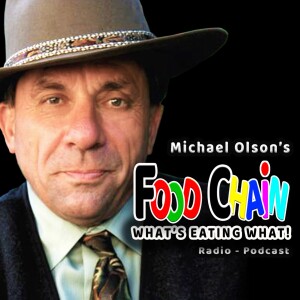
814
Downloads
61
Episodes
It’s a fact! 100% of men, women and children eat food, and 97.5% of must buy their food from others who bring it from an average of 2,000 miles away. And so the hungry ask: ”What’s in this tomato? Who planted that broccoli? Is it safe to eat genetically engineered corn? Why are they irradiating meat? Are we running short of water? Why is China growing our apples? What will happen to us if we can no longer farm? How safe is our food chain?” The Food Chain is an audience-interactive syndicated newstalk radio program and podcast broadcasting weekly on radio stations and streaming on demand on the internet. The Food Chain, which has been named the Ag/News Show of the Year by California’s legislature, is hosted by Michael Olson, author of the Ben Franklin Book of the Year award-winning MetroFarm, a 576-page guide to metropolitan agriculture. The Food Chain is available live via GCN Starguide GE 8 and delayed via MP3/FTP. For clearance and/or technical information, please call Michael Olson at 831-566-4209 or email michaelo@metrofarm.com
Episodes

Saturday Aug 03, 2024
Ep. 1351: Farming for the Certified Farmers Markets
Saturday Aug 03, 2024
Saturday Aug 03, 2024
Allen Moy, Executive Director, Pacific Coast Farmers Market Association
(California's Certified Farmers Markets)
They say, in the United States food travels an average of 1,500 miles from where it is grown to where it is eaten. That leads us to ask:
Can city dwellers close the distance to their food?
We begin with Michael Olson’s Second Law of the Food Chain: The farther we go from the source of our food, the less control we have over what’s in our food.
If, as is said, the average food in the United States travels 1,500 miles from where it is grown to where it is eaten, then we city people simply do not have much control over what is in our food.
Let’s consider, by way of example, shopping for some garlic, which can easily be found for sale in most every city grocery store. Approximately one-third of all garlic now being sold in the United States was grown by farmers over 5,000 miles away. The reason so much of the garlic we eat comes from so far away is that it costs less to grow it there, and ship it here.
When we shop for garlic, and see that the garlic that came from far away costs much less than the garlic that was grown here, we have to wonder – being ever the food skeptics – what is in the garlic that makes it so cheap?
We do have the intentions of those distant farmers who are growing our garlic. We also have all kinds of certifiers and inspectors with their rules and regulations that stand between those farmers and us.
How much can those garlic farmers care about the people who will be eating their garlic 5,000 miles away? What if those farmers decide that it would cost less to dry the garlic over a coal burning fire, even though the smoke from that fire would contaminate the garlic with mercury? If the coal-burning fire could save time and money, and make the garlic less expensive, and more competitive, would it not be a tempting production shortcut?
How much can all those food safety guardians with all their rules and regulations really protect against all the money that can be made with distance?
Those of us who live in the city have two choices when shopping for food. We can buy the cheap food that comes from far away, or we can find ways to close the distance to our food. And so we ask:
Where can city people find food with its farmer’s face on it?
